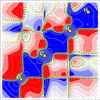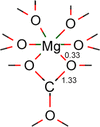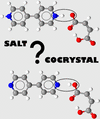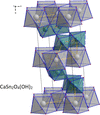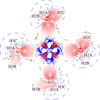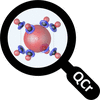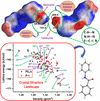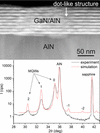issue contents
April 2025 issue
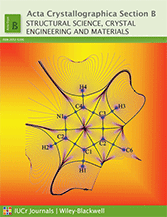
Cover illustration: Use of the GruPol database to predict the functional group dipole moments and polarizabilities of glucagon in the presence of NaCl is demonstrated by Ligorio et al. [Acta Cryst. (2025), B81, 192–201].
scientific commentaries
Free 

Yu & Gillet [Acta Cryst. (2025), B81, 168–180] extend quantum crystallography (QCr) by integrating real-space (1-RDM) and phase-space (Wigner function) representations, combining elastic and inelastic X-ray scattering to experimentally probe electron behavior in crystals. Their reconstruction of the quantum properties of a urea crystal bridges quantum chemistry and crystallography in a novel and imaginative way.
opinions
Open  access
access
 access
accessRelaxing the restriction that valence can only adopt integer values removes the distinction between ionic and covalent bonds, resulting in a simple and powerful valence theory that is able to predict the structures and chemical properties of both organic and inorganic compounds.
topical reviews
Open  access
access
 access
accessOne hundred years after the quantum theory established position and momentum as incompatible quantities, quantum crystallography offers a way to visualize electron phase space behaviour in crystals.
magnetic structures
Summary of the tools provided by the Bilbao Crystallographic Server for the analysis and determination of magnetic structures.
research papers
Open  access
access
 access
accessThis work explores the prediction of glucagon's dipole moments and polarizabilities using the GruPol database, incorporating ionic effects and solvation conditions. The results highlight the influence of high ionic concentrations on the protein's electrical properties, demonstrating good agreement with quantum mechanical benchmarks.
Open  access
access
 access
accessA minimally invasive use of a focused ion beam at grazing incidence can reduce the size of bulk crystals without jeopardizing the structural and electronic order parameters.
Download citation


Download citation


Open  access
access
 access
accessComputational salt–cocrystal differentiation, based on density functional theory improved by up-to-date functionals rSCAN and r2SCAN, has been tested for 404 structures. Several problematic structures have been redetermined.
Download citation


Download citation


Experimental electronic structure comparison of the multipole refinement with full dataset and the refinement using the low-order dataset with NospherA2 geometry.
Download citation


Download citation


At 623 K, the thermovapour treatment of calcium and tin oxides leads to the formation of the previously unknown CaSn2O4(OH)2 lamellar crystals. This phase is stable up to 973 K and has high catalytic activity and selectivity to C6+ products in the aldol condensation of acetone.
CCDC reference: 2299491
Download citation


Download citation


High-resolution single-crystal X-ray diffraction experiments were performed for Sm2Mn1–xGa6–yGey over a wide temperature range (180–430 K). The experiments revealed significant structural changes that are caused by structural disorder and magnetic ordering.
Intra- and intermolecular interactions and elastic properties of crystalline [Co(NH3)5NO2]ClNO3 are investigated.
The electron density and bonding nature of simple cubic Ca up to a phase 40 GPa is analyzed using theoretical quantum crystallography methods. The analysis is concerned with the electronic structure, pressure-induced electronic transitions, multi-center bond formation, topology of the electron density and atomic electronegativities.
Download citation


Download citation


The role of weak intermolecular interactions [C—H⋯N≡C, C—H⋯F—C(sp3) and C(sp3)—F⋯F—C(sp3)] in the presence or absence of strong N—H⋯O hydrogen bonds, in a series of CN and CF3 substituted crystalline N-phenyl benzamides is studied. Mapping of the crystal structure landscape for N-phenyl benzamide was performed by analysis of the crystal structures of the substituted compounds.
Strain in GaN/AlN superlattices decreases with increasing well/barrier thickness. The optimum superlattice interface quality is achieved for a structure with a barrier thickness of 3 nm. The quantum-confined Stark effect causes red-shift in photoluminescence spectra, confirmed by DFT calculations.
addenda and errata
Free 

Corrections to the article by König & Smith [Acta Cryst. (2022), B78, 665–677] are given.

 journal menu
journal menu








